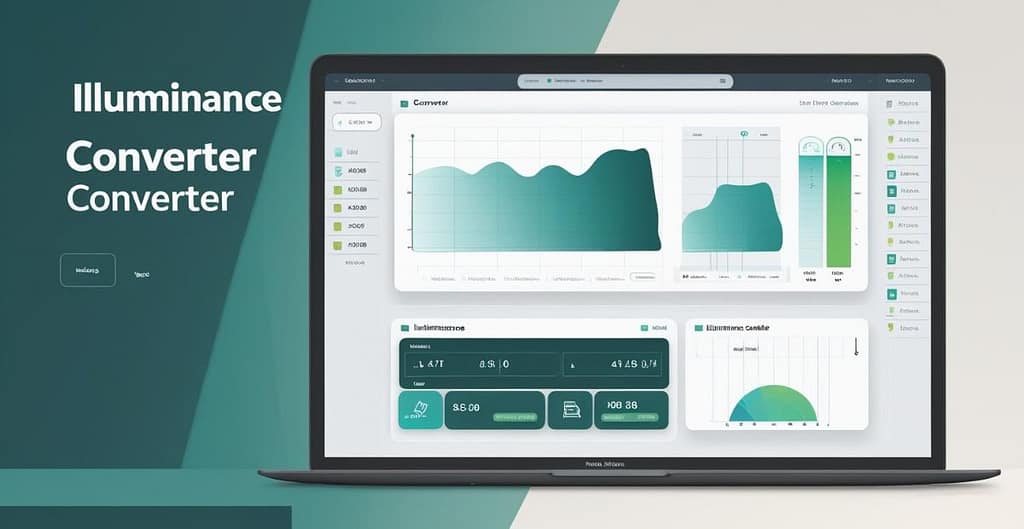Illuminance Conversion Calculator
Convert between lux, foot-candles, phots and other illuminance units with our accurate online converter
Illuminance Converter
Convert between common illuminance units
Understanding Illuminance Conversion
Illuminance measurement is essential in lighting design, architecture, photography, and various scientific fields. Our illuminance converter helps professionals and students quickly convert between different units of illuminance.
What is Illuminance?
Illuminance is the total luminous flux incident on a surface per unit area. It quantifies how much light reaches a surface and is a crucial parameter in lighting design, affecting visibility, mood, and functionality of spaces.
Common Illuminance Units and Their Applications
- Lux (lx) – The SI unit of illuminance, equal to one lumen per square meter. Used worldwide in most applications.
- Foot-candle (fc) – Imperial unit equal to one lumen per square foot. Still commonly used in the United States.
- Phot (ph) – CGS unit equal to 10,000 lux. Rarely used today but appears in some older literature.
- Nox (nx) – Unit used for very low light levels, equal to 0.001 lux.
- Meter-candle (m-cd) – Alternative name for lux, emphasizing its definition as lumen per square meter.
Conversion Formulas
Our converter uses precise conversion factors to ensure accurate results:
- 1 Lux (lx) = 0.0929 Foot-candles (fc)
- 1 Foot-candle (fc) = 10.7639 Lux (lx)
- 1 Phot (ph) = 10,000 Lux (lx)
- 1 Nox (nx) = 0.001 Lux (lx)
- 1 Meter-candle (m-cd) = 1 Lux (lx)
Practical Applications of Illuminance Conversion
Illuminance conversion is essential in various scenarios:
- Lighting Design – Converting between lux and foot-candles for international projects
- Photography – Understanding light levels for proper exposure settings
- Architectural Planning – Meeting building code requirements specified in different units
- Scientific Research – Standardizing measurements across studies from different countries
Illuminance Reference Values
| Environment | Lux (lx) | Foot-candles (fc) |
|---|---|---|
| Direct sunlight | 32,000 – 100,000 | 3,000 – 9,300 |
| Overcast daylight | 1,000 – 2,000 | 90 – 190 |
| Office lighting | 300 – 500 | 30 – 50 |
| Sunrise/sunset | 400 | 37 |
| Home lighting | 100 – 300 | 9 – 28 |
| Street lighting | 5 – 30 | 0.5 – 3 |
| Full moon | 0.1 – 0.3 | 0.01 – 0.03 |
Recommended Illuminance Levels
Different activities require specific illuminance levels for optimal performance and comfort:
- Public areas with dark surroundings: 20-50 lux
- Simple orientation for short visits: 50-100 lux
- Working areas where visual tasks are occasionally performed: 100-200 lux
- General offices, classrooms: 300-500 lux
- Supermarkets, mechanical workshops: 500-750 lux
- Detailed drawing work, automotive inspection: 750-1,000 lux
- Operations requiring extreme precision: 1,000-2,000 lux
Frequently Asked Questions
Illuminance is the total luminous flux incident on a surface per unit area. It quantifies how much light reaches a surface and is measured in lux (lx) in the SI system, or foot-candles (fc) in the imperial system. 1 lux equals 1 lumen per square meter. It’s typically measured using a light meter or lux meter placed at the surface where illumination needs to be measured.
To convert lux to foot-candles, divide the lux value by 10.764. To convert foot-candles to lux, multiply the foot-candle value by 10.764. For example, 100 lux equals approximately 9.29 foot-candles. Our converter automates this calculation for accurate results, handling both common and rare illuminance units.
Typical illuminance values vary widely: starlight (0.0001-0.002 lux), moonlight (0.1-1 lux), residential lighting (100-300 lux), office lighting (300-500 lux), retail spaces (500-1000 lux), and direct sunlight (up to 100,000 lux). These values help lighting designers create appropriate lighting schemes for different applications and environments.
A phot (ph) is a unit of illuminance in the centimeter-gram-second system equal to 10,000 lux. It represents one lumen per square centimeter and is rarely used in modern applications, having been largely replaced by lux. You might encounter it in older lighting literature or certain specialized fields, but for most practical purposes, lux is the preferred unit.
Different illuminance units exist due to historical development of measurement systems in different regions and for various applications. The metric system uses lux while the imperial system uses foot-candles. Some specialized units like nox are used for very low light levels. Understanding these different units is important when working with international standards, older documentation, or specialized applications.
Our illuminance conversions are mathematically precise based on established conversion factors. However, in practical applications, other factors like measurement device accuracy, environmental conditions, and spectral distribution of light can affect real-world measurements. For most engineering and design purposes, our conversions provide sufficient accuracy.

Use our more free tools
Volumetric Flow Rate Converter
Reactive Energy Converter tool
Apparent Power Converter
🔗 Learn More
For in-depth information, visit the Wikipedia page on Illuminance.